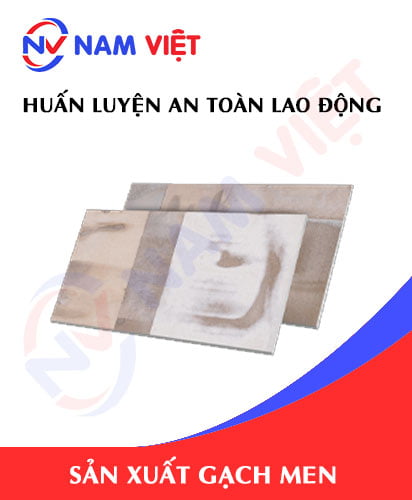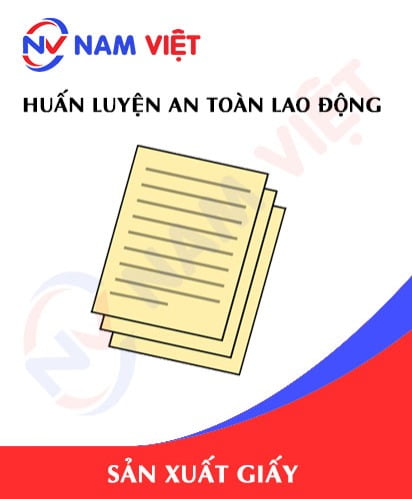Occupational safety training for ceramic tile manufacturing
99,000 ₫
Note: The above price is calculated per person, the price may fluctuate depending on the number of learners participating in the course and the market movement, for more accurate price support please refer to the pricing table or contact our consultants directly.
Occupational safety is an important issue in factories manufacturing ceramic tiles and needs to be addressed promptly to ensure the health and safety of workers, enhancing the reputation of businesses. The Safety training course is one of the effective solutions to raise awareness about how to prevent occupational accidents for workers involved in manufacturing ceramic tiles.
Table of Contents
Toggle1. Overview of ceramic tiles
a. What are ceramic tiles?
- Ceramic tiles are products of the firing process of clay or sandy clay, often used to build houses or other construction works. Ceramic tiles have a shiny, smooth, and very hard surface, often red or brown. Ceramic tiles have high durability, can withstand the effects of weather and time, and are widely used all over the world.
- The ceramic tile manufacturing industry is one of Vietnam’s traditional industries, which developed from the 1950s with small family workshops. However, in recent years, the ceramic tile manufacturing industry has grown stronger with investment in more modern technology and production management.
- Currently, Vietnam is one of the largest ceramic tile producers in Southeast Asia, with many large ceramic tile manufacturing enterprises such as Viglacera, TASA, LAFARGE, Dong Nai Brick, SON HA, and many other smaller ceramic tile factories across the country.
- In recent years, Vietnam’s ceramic tile manufacturing industry has been promoted for development, and many businesses are investing in more modern manufacturing technology, aiming to improve product quality and enhance competitiveness in the market. However, it is also necessary to pay attention to issues of environment and labor safety during the manufacturing process.

b. Types of ceramic tile manufacturing machinery
The types of ceramic tile manufacturing machinery include:
- Mixer: used to mix clay, water, and chemical components to create a clay mixture for ceramic tile manufacturing.
- Press: used to press the clay into the shape of a ceramic tile. There are many types of presses such as manual presses, block presses, automatic presses, etc.
- Tile cutter: used to cut ceramic tiles into different sizes according to customer requirements.
- Tile stacker: used to stack tiles on top of each other into rows or pallets for packaging.
- Kiln: used to fire ceramic tiles to create hardness and load-bearing capacity for the product.
- Grinder: used to polish and smooth the surface of ceramic tiles before packaging and selling to the market.
These machines are often automated in the manufacturing process to increase productivity and reduce manufacturing costs.

c. Typical ceramic tile manufacturing enterprises
Typical ceramic tile manufacturing enterprises in Vietnam include the following:
- Viglacera Ha Long: is a subsidiary of the Viglacera group specializing in the manufacturing of ceramic tiles, wall and floor tiles, and related products.
- Lac Hong Investment Construction Joint Stock Company: is a large-scale ceramic tile manufacturing enterprise in Vietnam, providing a variety of products for both domestic and international markets.
- Nghi Son Ceramic Joint Stock Company: is one of the leading enterprises in Vietnam manufacturing ceramic tiles and pottery with a modern manufacturing process.
- PRIME was established in 1999 with its first factory in Vinh Phuc. Today it is recognized as one of the leading manufacturers in the field of ceramic tiles, roofing tiles, and water heaters in Vietnam and the ASEAN region, with over 4,400 employees and 16 member companies of Prime Group.
- Dai Viet Group: is a group that manufactures ceramic tiles, pottery, granite, and other building materials. The company has a large-scale manufacturing capacity in Vietnam and exports to many international markets.
- Tan Quang Minh Ceramic Joint Stock Company: is an enterprise that manufactures ceramic tiles and pottery with advanced technology, diverse products, and guaranteed quality.
d. Specific jobs in a ceramic tile factory
Group 1
- Executive director, deputy executive director, department head in a ceramic tile factory.
Group 2
- Safety officer: manages safety in the factory, designs safety procedures, supervises and urges employees to comply with safe work procedures.
Group 3
- Raw material preparation: First, the necessary raw materials for manufacturing ceramic tiles such as clay, minerals, stone powder, gypsum powder, etc., will be prepared and mixed in proportion.
- Ceramic tile pressing: After mixing the raw materials, they are pressed into ceramic tile blocks using a press machine. After that, the ceramic tiles are put into a drying kiln to dry.
- Ceramic tile firing: The ceramic tiles are arranged in a kiln and fired at a specific temperature and for a certain period of time to create the hardness and durability of the ceramic tiles.
- Quality inspection: After the ceramic tiles are manufactured and fired, the products will be quality-checked to ensure they meet technical requirements and quality standards.
- Packaging and transportation: Ceramic tiles, after quality inspection, will be packaged and transported to sales points or construction sites.
Group 4
- Office jobs, serving, sales, marketing.
- Production management, quality management, human resource management, material management, financial accounting management.
- Research and development of new products, designing product packaging.

2. Overview of the safety training course for manufacturing ceramic tiles
Within the scope of this article, we focus on issues related to Group 3, because Group 3 is the group directly involved in the production process, bearing the highest risk of labor accidents. Refer to other groups here
a. What is Group 3 labor safety training?
- Labor safety training for Group 3 are classes that equip workers with awareness of how to prevent labor accidents.
- The labor safety training course will help workers recognize and avoid dangers, limiting the risks of labor accidents while working.
b. Training duration
Initial safety training duration
- The total training duration is at least 24 hours, including the test time.
- 8 hours of theoretical study on the policy system and laws on labor safety and hygiene
- 8 hours of theoretical study on basic knowledge of labor safety and hygiene
- 4 hours of theoretical study on specialized training content
- 2 hours of practical study on specialized training content
- 2 hours of theoretical test at the end of the training course
The safety training center will distribute the time into several training sessions depending on the time arrangement for the staff. However, there will usually be 6 training sessions, the course will last 3 days, on the condition that the manufacturing enterprise can arrange continuous study time.
Periodic safety training duration
- Before the labor safety card expires, if the worker wants to get it re-issued, they must go through a periodic labor safety training course, with a periodic safety training duration of at least 50% of the initial safety training duration.
Explanation: The total periodic labor safety training duration is at least 12 hours, including the test time. After completing the periodic training course and passing the test, workers will be re-issued or have their labor safety card extended.
c. Content of the training course
| No. | TRAINING CONTENT | TRAINING DURATION (HOURS) | |||
| Total | Of which | ||||
| Theory | Practice | Test | |||
| I | Policy and legal system on labor safety and hygiene | 8 | 8 | 0 | 0 |
| 1 | Overview of the legal document system on labor safety and hygiene. | 6 | 6 | ||
| 2 | System of technical standards and regulations on labor safety and hygiene. | 1 | 1 | ||
| 3 | Specific regulations of state management agencies on labor safety and hygiene when newly building, expanding or renovating projects, facilities for manufacturing, using, preserving, storing and inspecting types of machinery, equipment, materials, and substances with strict requirements on labor safety and hygiene. | 1 | 1 | ||
| II | Basic knowledge of labor safety and hygiene | 8 | 8 | 0 | 0 |
| 1 | Basic knowledge of hazardous and harmful factors at the workplace. | 4 | 4 | ||
| 2 | Methods to improve working conditions. | 1 | 1 | ||
| 3 | Safety culture in manufacturing and business. | 1 | 1 | ||
| 4 | Rights and obligations of the employer, the employee; policies and regulations on labor safety and hygiene for employees; functions and duties of the safety and hygiene network. | 1 | 1 | ||
| 5 | Labor safety and hygiene regulations, safety and hygiene signs and instructions, and the use of safety equipment and personal protective equipment; professional skills in first aid for labor accidents, and prevention of occupational diseases. | 1 | 1 | ||
| III | Specialized training content | 6 | 4 | 2 | 0 |
| General knowledge about types of machinery, equipment, and substances that generate hazardous and harmful factors; analysis, assessment, and management of labor safety and hygiene risks, safe work procedures with machinery, equipment, and substances that have strict requirements on labor safety and hygiene. | 6 | 4 | 2 | ||
| IV | Safety training test at the end of the training course | 2 | 2 | 0 | 0 |
| Total | 24 | 22 | 2 | ||
See more training content for 6 groups
d. Labor safety card
After completing the labor safety training course and passing the test, workers will be issued a labor safety card (in practice, also known as a Group 3 labor safety certificate).
The Group 3 safety card will clearly show information such as: full name, date of birth, specific job and working environment. It also includes the training duration, a red seal, and a signature confirming the completion of the training course.
According to the regulations for issuing safety cards specified in Clause 2 of Article 24 of Decree 44/2016/ND-CP, there are two cases:
- If the employer and the employee have a labor contract, the employer must sign, seal, and laminate the safety card for the trained person in Group 3 after they have completed the training course from the training unit and passed the test.
- If the worker is a freelancer or seasonal worker and does not have a labor contract, the training unit must sign, seal, and laminate the safety card for the worker after they have completed the training course from the labor safety training unit and passed the test.

3. Identifying hazards when manufacturing ceramic tiles
Common hazards when manufacturing ceramic tiles include:
- The use of fuels such as gas in the ceramic tile manufacturing process can pose a risk of fire and explosion. Therefore, it is necessary to comply with labor safety and hygiene regulations, use personal protective equipment such as masks, face masks, gloves, safety glasses, specialized shoes, and be equipped with a complete fire extinguishing system in case of fire or explosion.
- Machinery in the ceramic tile manufacturing process can cause labor accidents, such as grinding, mixing, pressing, cutting, and firing. Employees often have to come into contact with heavy equipment, cutting tools, and operating machinery, so it is necessary to have training procedures, guidance, and ensure the safety of employees during work.
- The ceramic tile manufacturing process can create air pollution and waste such as dust, liquid waste, and solid waste. The treatment and disposal of waste must comply with legal regulations and ensure no environmental pollution.
- During the ceramic tile manufacturing process, employees may be exposed to dust, fly ash, chemicals, and allergenic agents. Therefore, it is necessary to use personal protective equipment to avoid infection and ensure the health of workers.
4. Labor accidents that often occur when manufacturing ceramic tiles
The labor accidents that often occur in ceramic tile manufacturing include:
- Accidents with machinery: During the operation of ceramic tile manufacturing machinery, employees may get stuck, crushed, cut, melted, or burned.
- Accidents with chemicals: Ceramic tile manufacturing can use chemicals to create color or shine. Employees may get burned or inhale toxic fumes.
- Accidents with electricity: Electrical equipment in a ceramic tile factory can cause electrical hazards. Employees may get an electric shock if they do not use or store the equipment correctly.
- Accidents with craftsmanship: Ceramic tile manufacturing employees may suffer injuries when they have to work in difficult and prolonged postures.
- Accidents with materials: Employees may suffer injuries if stones, heavy tiles, or other materials fall on them while working.
5. Safety measures when participating in the manufacturing of ceramic tiles
Some safety measures when participating in the manufacturing of ceramic tiles include:
- Ensure the use of protective equipment such as hard hats, safety glasses, gloves, safety shoes, face masks, etc.
- Implement periodic workshop cleaning to avoid dust and harmful substances that can harm health.
- Provide adequate safety measures and training for workers to correctly use protective equipment as well as guide them on safe working skills and procedures.
- Implement periodic maintenance and repair of manufacturing equipment to ensure worker safety.
- Use safe manufacturing materials and chemicals and ensure compliance with fire prevention and fighting regulations.
- Ensure safety for product transportation and loading/unloading to avoid accidents when working in the warehouse.
- Identify and evaluate labor safety risks and propose timely preventive measures.
- Strengthen waste management and proper disposal to avoid environmental pollution and harm to workers’ health.
- Ensure full application of legal regulations related to labor safety and environmental regulations.
- Perform risk assessment and classify hazards in the manufacturing process to propose preventive measures, minimizing the risks of labor accidents.
- Periodically organize work environment monitoring in the factory, collect and analyze harmful factors for workers, thereby adjusting to reduce the harm level to prevent occupational diseases for them.

6. Benefits of safety training for manufacturing ceramic tiles
An Toan Nam Viet provides your business with great benefits after completing labor safety training courses as regulated in Decree 44/2016/ND-CP on labor safety and hygiene, for companies and factories.
- Workers can recognize the potential risks of labor accidents and, from there, have preventive measures to avoid labor accidents.
- Your business can establish risk prevention measures in the production, operation, and maintenance processes.
- Minimize costs when unsafe situations occur in labor.
- Uninterrupted production processes will help increase labor productivity and product quality.
- Comply with labor safety laws, avoiding legal risks.
- Create a professional and reputable image in all aspects, thereby enhancing the brand for your business.
Nam Viet’s training courses are the solution to prevent and combat external factors that can affect each individual so they can avoid dangers that can lead to injury or, more seriously, death.
7. Customer feedback after completing the safety training course for manufacturing ceramic tiles
An Toan Nam Viet has many years of experience in the mission of accompanying many businesses in Vietnam in general and in the southern provinces in particular. And that responsibility is something extremely valuable to Nam Viet, which is why Nam Viet’s Labor Safety Training work is always focused on becoming more and more professional. The motivation for An Toan Nam Viet to grow strong to this day comes from the positive feedback and suggestions from businesses. Below are the responses from our partners whom we have served.
Bac Nam E&C Investment and Construction Joint Stock Company
“The first time I used the service at An Toan Nam Viet, I was very surprised by the enthusiastic 24/7 support of the consulting team. The class organization was very fast and convenient for our company, thank you very much for Nam Viet’s service!”
Hoa Dat Construction and Trading Joint Stock Company
“Nam Viet’s service has helped us a lot in simplifying labor safety and the process of completing safety records for our work. The consulting team is enthusiastic and timely in answering our questions. 5 stars for Nam Viet”
See more customer interviews after using An Toan Nam Viet’s service
8. An Toan Nam Viet’s Labor Safety Training capacity
An Toan Nam Viet is a reputable and quality labor safety training center in Vietnam today. With labor safety training sessions taking place continuously at manufacturing workshops, factories, or construction sites across the country (63 provinces in Vietnam).
License for labor safety training
- An Toan Nam Viet has been inspected and licensed by the Department of Labor Safety of the Ministry of Labor – Invalids and Social Affairs, which issued a certificate of eligibility to operate in labor safety and hygiene training. This further strengthens our capacity for labor safety training.

Documents and lectures
- Before the labor safety training documents are put into the labor safety training courses, they have been reviewed and approved to ensure that the lectures are accurate in knowledge and effective when applied.
- The teaching method of the lecturers is synchronized according to the teaching standards of An Toan Nam Viet, which is a method that experts in labor safety and hygiene training have researched and concluded during the teaching process to bring the highest knowledge absorption efficiency to students.
Facilities
- Controlling the factors in the classroom that affect the training process will increase the teaching performance and the knowledge absorption efficiency of students.
- Our training course supporting facilities always have spacious classrooms that meet standards for area, lighting, training equipment, etc.
9. Reputable and quality safety training center nationwide
At An Toan Nam Viet, we always prioritize our professional dedication to labor safety training. To us, conveying knowledge on self-protection to workers so that they can have a safe journey on their livelihoods is a contribution to building the country.
To ensure effective training, we carefully and meticulously prepare every small detail. From preparing tools, equipment, and teaching devices to textbooks, documents, sound, and lighting.
Our labor safety training lecturers are experts with many years of experience in the field. They even have research projects on identifying dangers in all occupations and how to prevent them.
The lecturers’ lectures are drawn from practice and are conveyed in the most vivid and easy-to-visualize way for workers. These factors help workers feel comfortable during the study period and absorb our taught knowledge well. Of course, the knowledge conveyed always closely follows Decree 44/2016/ND-CP.
From there, they grasp many measures to prevent dangers and how to protect themselves. At the same time, they also apply them in the most suitable way in their actual work.
Our safety training center is proud to be a reputable and professional provider of labor safety training services with the following advantages:
- Competitive training costs but training quality is still ensured.
- Flexible training schedule to suit the production situation of the company.
- The procedure for issuing labor safety training certificates is fast and in accordance with the law.
- The training lecturers are people with many years of experience in the profession.
- The classroom is controlled for factors that affect the training process to increase teaching performance and knowledge absorption efficiency of students.
- The lectures are compiled to be suitable for labor safety work at businesses.
- An Toan Nam Viet works with dedication and professionalism to support customers accurately and quickly.

10. See more reference materials for safety training for manufacturing ceramic tiles
- Safety documents for manufacturing ceramic tiles
- Set of labor safety training documents
- Set of labor safety training test questions
- Multiple-choice test on labor safety for manufacturing ceramic tiles
- Slides for labor safety training lecture for manufacturing ceramic tiles
1 review for Occupational safety training for ceramic tile manufacturing
No comments yet















namchinh.haiphong341
Cảm ơn trung tâm! tôi rất hài lòng với dịch vụ